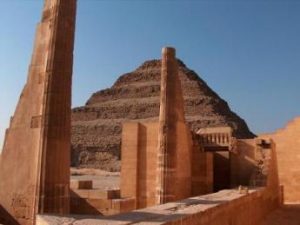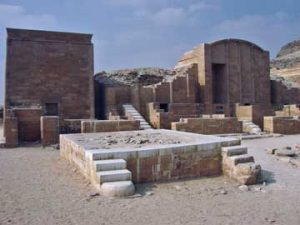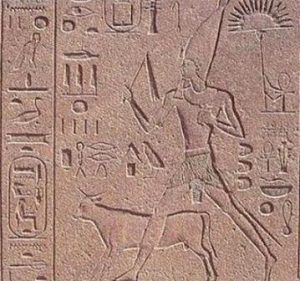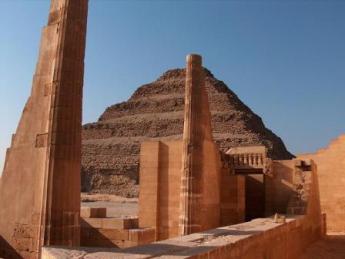The Sed festival (Heb Sed), named after the jackal god "Sed", was the most important celebration of kingship in ancient Egypt. Its origin rooted in the pre-dynastic times (before 3150 BC) and lasted until the Ptolemaic Period, celebrating the continued rule of the pharaoh. The festival started during the month of Choiak, the fourth month of the inundation season. Some kings have built a whole new festival temple dedicated to this purpose, while others reconstructed a festival hall on already existing temple.

Frontal view Heb Sed Court at King Djoser's Step Pyramid complex at Saqqara
The festival aimed to renew the reigning king's power that had become depleted over time, endangering the continued existence of the state. This was a replacement of the more ancient ritual of killing the king who became unable to continue his reign effectively because of ageing. The rituals represented a symbolic burial of the old king and a repeat coronation to continue to reign as a new king. The ceremonies also represented a reenactment of the unification of Egypt by Menes, founder of the First Dynasty.
The first festival was traditionally celebrated in the king's 30th regnal year, since 30 years was a round number signifying a generation. The festival was then repeated every three years thereafter. Amonhotep III (18th Dynasty) – who reigned for 37 years - celebrated three Sed festivals, while Ramses II (19th Dynasty) - who reigned for 67 years - celebrated 13 or 14 festivals, as he often left 2 instead of 3 years between his Heb Seds. Pharaohs who did not reign that long had to be content with promises of "millions of jubilees" in the afterlife.
However, several kings celebrated their first Sed at a much earlier date. Hatshepsut (18th Dynasty) held her first jubilee during her 16th regnal year, as she counted her 4 years of co-regency with Thuthmose II (her husband and the preceding king) and the 7 years co-regency with his son Thuthmose III. She thus marked the 30 years count since the death of her father, Thutmose I, from whom she derived all of her legitimacy to rule Egypt. The festival was commemorated at Karnak, where blocks from the reconstructed Red Chapel show her as king, and running with the Apis bull between the markers.
Amenhotep IV (Akhenaton) dedicated his festival to the solar-god Aton on his 3rd regnal year. Since a Sed-festival was a royal jubilee intended to reinforce the pharaoh's divine powers and religious leadership, this gave him advantage against the powerful priests of Amon-Ra. His early celebration coincided with the festival that his father, Amenhotep III would have celebrated in his 40th year as king. There is a possibility that Akhenaton has celebrated another Sed later during his 17 years of kingship.
The ceremony implied certain temple rituals and offerings in cycles of scenes that are best preserved in the Sun Temple of King Niusera (5th Dynasty) in Abu-Ghurab (6 miles southwest of cairo, near Abu-Seer). On the first day, the king presented offerings to the gods; then was seated and crowned on a raised platform provided with two thrones that represented Upper and Lower Egypt. Images of provincial deities in a series of shrines were shown beside the double throne, specifically the cobra-goddess Wadjet of the Delta town of Buto, and the vulture goddess Nekhbet of el-Kab; symbols of Upper and Lower Egypt. The priests carried the statues of the gods and presented offerings, in a sign of giving thanks for past loyalty or to secure good relationships in the future.

the platform on the west side of the complex where the king was seated
The king was then attired a short kilt with a bull's tail in its back, which probably gave the festival a less formal name: "The Feast of the Tail". In the open space between the two rows of shrines, the king ran a ritual race alongside the Apis Bull four times as the ruler of Lower Egypt wearing the Red Crown, and four times as that of Upper Egypt wearing the White Crown. The course was bounded by two points symbolizing the borders of Egypt to reinforce his dominion over the whole kingdom, and at the same time he dedicates it to the gods. In doing so, he proved that he was still physically able to rule the country, and was thus rejuvenated and reborn. Finally, he was carried in a procession to visit the chapels of the gods. He was carried first as king of Lower Egypt by the "Great Ones of Upper and Lower Egypt" to the chapel of Horus, where he receives the crook and the flail. Next, as king of Upper Egypt, he was carried to the two chapels of Horus of Edfu and Seth of Ombos, where he was handed a bow and arrow, with which he shoots an arrow in each one of the four directions.

Djoser performing the ritual run with Apic Bull
"Raising The Djed Pillar" was an important part of the Heb Sed ceremony that started during the beginning of the 12th Dynasty (or perhaps as early as the 6th) to represent Osiris's triumph over Set. The pillar stood on a shrine, and with the help of the priests, the king would raise a wooden djed column using ropes. Offerings were presented before the pillar and below the ropes, and re-enactments of the myth of Osiris and Isis were performed. Later, a poem describing Isis and Nephthys' search for Osiris was added to the ceremony.
This ritual symbolized the myth of Osiris and Isis. The myth tells the story of Set killing his brother Osiris, placed him in a coffin which he threw in the Nile. Hapi, the Nile god carried the coffin to the sea, where eventually it was cast ashore of Byblos in Syria. The waves cast it into a tree on the shore, which became a resting place for the hidden body of Osiris. The Phenecian king, intrigued by the tree's quick growth and unaware of its content, ordered it cut down and installed as a pillar in his palace. Isis, her sister Nephthis and the jackal Anubis went ranging allover in search of the coffin. After a long quest Isis reached Byblos and went to serve into the king’s palace. In return for her caring of their young prince, the king gave her the pillar as a gift. Isis extracted the coffin out, and consecrated the pillar which became known as the Pillar of Djed.

Seti I offering the Djed Pillar to Isis at Seti I temple at Luxor
Amenhotep III altered the ritual to take place on the great artificial lake he built at Malkata, where he and statues of various deities sailed along in barges in order to symbolically recreate the voyage of the sun god through the underworld. Probably this was a reviving of a more ancient tradition, as a limestone relief shows Senusert I (12th Dynasty) celebrating his Sed festival while holding an oar, with an inscription that reads, "hastening by boat to Min, the god in the midst of the city".
The festival is believed to have originated from the very beginning of Egypt's recorded history during the Pre-dynastic era. The oldest example of this Sed festival is believed to be that found on the decoration of the ritual mace head of King Narmer (1st Dynasty), though it is possible that it does not represent the Heb Sed. A small ebony label found attached to a jar from the tomb of King Den (1st Dynasty) at Abydos depicted the king running around the ritual course and carrying the Heb Sed insignia. To the left of the figure is a platform raised on few steps on which a double shrine stood. The king is once again depicted in the shrine sitting on a throne and wearing the Double Crown of Upper and Lower Egypt.
From the 4th Dynasty onwards, there are much evidence that the festival was celebrated over periods of time. One of the more remarkable signs of the Heb Sed can be found at the Djoser (3rd Dynasty) Step Pyramid complex at Saqqara, where remnants of the Heb Sed court were found, as well as an inscription on a false doorway inside the pyramid. Also at Saqqara, reliefs were found at the tomb of Pepi I (6th Dynasty) that showed the king performing the ritual run. At the Bent Pyramid at Dahshour, Snefru (4th Dynasty) is seen on a stele wearing the Heb Sed robe. Karnak also show some traces of a small Heb Sed temple of Amonhetep II (18th Dynasty) as well as the "Festival Temple of Thutmose III".
Akhenaton's celebration is found in the colonnaded court of the Temple of Aton at Karnak. Aton is seen taking part in a Sed festival of its own, contrary to the tradition of gods giving Sed festivals to the king and never taking part in the ritual themselves. It remained to be celebrated by the later Libyan-era kings (22nd Dynasty) such as Shoshenq III, Shoshenq V, Osorkon I, and Osorkon II. The later built a massive temple for the goddess Bastet at Bubastis, with a red granite gateway decorated with scenes of this jubilee that showed him seated in his Heb Sed kiosk and wearing the typical robe for the ceremony. Carved reliefs from the Greek Period at Kom Ombo also show Ptolemy VIII receiving Heb Sed symbols from the god Horus.
Pictures 1, 2 & 3 are from the Heb Sed Court at King Djoser's Step Pyramid complex at Saqqara. Picture 4 is from Seti I's Temple at Luxor.





Louise - 4 years ago
Hello again, I have another question. Which city is the god Min in, in this paragraph? thank you again. Louise
Amenhotep III altered the ritual to take place on the great artificial lake he built at Malkata, where he and statues of various deities sailed along in barges in order to symbolically recreate the voyage of the sun god through the underworld. Probably this was a reviving of a more ancient tradition, as a limestone relief shows Senusert I (12th Dynasty) celebrating his Sed festival while holding an oar, with an inscription that reads, "hastening by boat to Min, the god in the midst of the city".
Louise - 4 years ago
Hello again I have another question. I did not know that other countries could be a Pharoah Libya and Greece could be at the Heb Sed Festival. This has me confused? thank you again Louise
“It remained to be celebrated by the later Libyan-era kings (22nd Dynasty) such as Shoshenq III, Shoshenq V, Osorkon I, and Osorkon II. The later built a massive temple for the goddess Bastet at Bubastis, with a red granite gateway decorated with scenes of this jubilee that showed him seated in his Heb Sed kiosk and wearing the typical robe for the ceremony. Carved reliefs from the Greek Period at Kom Ombo also show Ptolemy VIII receiving Heb Sed symbols from the god Horus”
Louise - 4 years ago
Hello I am reading one of your articles about the Heb Sed Festival. Would you mind please answering a question? I am not understanding this sentence. Does this mean that Akhenaton did not take part in the Festivals rituals? many thanks .
“Akhenaton's celebration is found in the colonnaded court of the Temple of Aton at Karnak. Aton is seen taking part in a Sed festival of its own, contrary to the tradition of gods giving Sed festivals to the king and never taking part in the ritual themselves.”